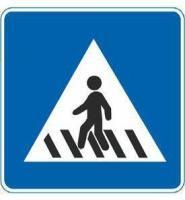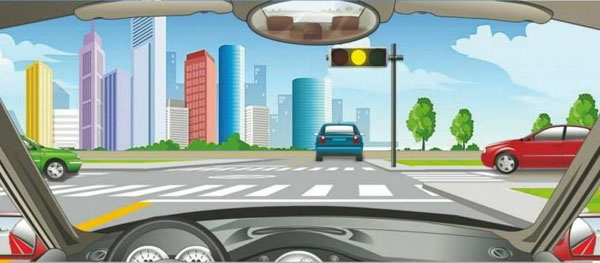1、When overtaking on a rainy day, drivers should turn on headlamps and sound a long horn.
A、Right
B、Wrong
Answer:B
2、When seeing this sign, the driver should reduce speed and observe the road conditions.

A、Right
B、Wrong
Answer:A
3、Speed up and pass when encountering this traffic light at the intersection

A、Right
B、Wrong
Answer:B
4、When driving in a strong wind, drivers should abruptly turn the steering wheel to return to the original direction if they feel the vehicle deviates horizontally due to a strong gale.
A、Right
B、Wrong
Answer:B
5、When a vehicle approaches an intersection without crosswalk, the driver should _______ if he finds people are crossing the street.
A、Reduce speed or stop to yield
B、Honk to indicate them to yield
C、Pass before the pedestrians
D、Immediately change lane and bypass the pedestrians
Answer:A
6、When rescuing a person sustaining full-body burns the rescue personnel may spray cool water to his body to put out the fire.
A、Right
B、Wrong
Answer:B
7、When the engine suddenly stalls on the road, what should the driver do?
A、Stop the vehicle and overhaul it immediately
B、Immediately turn on the hazard lamps
C、Move the vehicle to a place where it will not obstruct the traffic flow
D、Set up a breakdown warning sign
Answer:BCD
8、When the tire pressure is too low, what can happen when driving at a high speed?
A、Tire pressure will be unstable
B、Tire pressure will increase
C、Driving resistance will decrease
D、The tire will burst
Answer:D
9、When a wounded person suffering burns is thirsty, he may drink a small quantity of slightly salty water.
A、Right
B、Wrong
Answer:A
10、What should be done by the driver who intends to overtake but the motor vehicle in front neither reduces its speed nor allows the right of way?
A、Continuously sounding the horn and accelerating to overtake
B、Accelerating and continuing to overtake
C、Refraining from overtaking
D、Following the vehicle in front closely and finding a chance to overtake
Answer:C
11、When a fast-running vehicle makes a sharp turn, it can very easily cause side collision or an overturn due to the centrifugal force.
A、Right
B、Wrong
Answer:A
12、When encountering such pedestrians, motor vehicle drivers may continuously sound the horn to alert them to yield.

A、Right
B、Wrong
Answer:B
13、What is the meaning of this sign?

A、Slippery section
B、Sharp curve
C、Inverse curve
D、Continuous curves
Answer:C
14、When rescuing the injured, it is necessary to ________.
A、Save life first and treat the wounds later
B、Treat the wounds first and safe life later
C、Help the slightly wounded persons first
D、Help the seriously wounded persons later
Answer:A
15、What is the meaning of this sign?

A、Special lane for small vehicles
B、Special lane for motorized vehicles
C、Special lane for taxis
D、Special lane for multi-passenger vehicles
Answer:D
16、Matches, sulfur and red phosphorus are _________.
A、Explosives
B、Inflammable solid materials
C、Self-igniting articles
D、Oxidizing materials
Answer:B
17、When driving, the driver should yield to _______.
A、Ambulance
B、Fire engine
C、School bus
D、Police car
Answer:ABCD
18、Under such circumstances, what should be done by motor vehicle drivers in order to yield to the pedestrians politely?

A、Set off after pedestrians pass
B、Set off and bypass in front of the pedestrians
C、Sound the horn to warn the pedestrians to yield
D、Set off and approach the pedestrians slowly
Answer:A
19、What is the meaning of this sign?

A、Y-shaped intersection
B、T-shaped intersection
C、Intersection
D、Ring intersection
Answer:B
20、Rescue personnel should check the breath of the unconscious person before applying any other emergency treatment.
A、Right
B、Wrong
Answer:A
21、When passing another vehicle on a foggy day, what should drivers do?
A、Slow down and pass slowly
B、Maintain a safety distance
C、Properly use lamps
D、Drive at a high speed
Answer:ABC
22、Drivers who ride motorcycles are able to not wear safety helmets.
A、Right
B、Wrong
Answer:B
23、What is the meaning of this sign?

A、Turn right
B、One-way road
C、Going straight only
D、Straight-going lane
Answer:A
24、Which of the following can effectively avoid driving fatigue
A、Take a proper rest after dinner before driving.
B、Driving continuously for no more than 4 hours
C、Keep a Good Sleep
D、Do npt eat too much
Answer:ABCD
25、The wrong measure to ride a motorcycle in summer is to __________.
A、Drive at a high speed for a long time
B、Control the speed by the accelerator
C、Avoid using the brake
D、Avoid loading people or cargoes
Answer:A